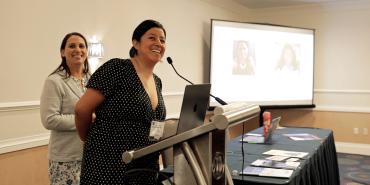What happens when teachers are in charge? What happens when they design the curriculum, make the hiring decisions, take over observation and evaluation, and even let students participate in schoolwide decisions? Great things: Teacher retention goes up; student performance goes up; and community involvement goes up. That’s according to data presented by Taryn Snyder and Wendy Salcedo-Fierro in “Teachers at the Helm: When Teachers Run Schools,” one of the Lunch & Learn sessions at the AFT TEACH conference.
Snyder, a member of the Boston Teachers Union, and Salcedo-Fierro, a member of the United Teachers Los Angeles, teach at two of the 300 teacher-powered schools across the country. The benefits, they said, don’t just show up in the performance data—they show up every day in every class, every teacher and every student.
“This model has allowed us to build a place where teachers want to teach and kids want to learn,” Salcedo-Fierro said. “We ask kids and parents what they want to focus on; and because teachers are in charge, we can make changes quickly. We decide the focus of the curriculum.”
Snyder agreed. “We all went into teaching to work with kids and make decisions that are best for kids. In traditional top-down schools, that’s not always possible,” she said. “In a teacher-powered school, if something isn’t working, we figure out the answer. And just by being part of the decision-making process, we’re more motivated.”
But if teachers are making the decisions, where do principals come in? Because teachers decide, it depends on the school, they said. For example, some teacher-powered schools don’t even have principals. Salcedo-Fierro’s school, UCLA Community School, has three principals. But in all teacher-powered schools, the role of the principal is to collaborate with teachers because they use what’s called a “distributed leadership” model.
At Snyder’s school, the Boston Teachers Union Pilot School, teachers developed a rubric to guide how decisions are made and who makes them. In some cases, decisions lie solely with one of the teacher-run committees. In other cases, it requires a full-faculty vote and an 85 percent approval rate. They started out with a simple thumbs-up, thumbs-down system.
“If even one thumb went down, the initiative didn’t pass,” Snyder said. “And every person who had a thumb down had to explain what was getting between them and a yes vote. It was usually just that someone needed more clarification or wanted to discuss things a little more.” That discussion always improved the initiatives under consideration, and always made teachers appreciate the process, she said.
Students also have a role in governance in teacher-powered schools, and at Snyder’s school, some have even participated in the teacher hiring process. And the students, along with the teachers, vote on who will be the principal. The process has a broader purpose, Salcedo-Fierro said: “Democratic schools with democratic classrooms prepare kids to be part of a democratic society. Teacher-powered schools don’t just meet kids’ academic needs. They meet all their needs.”
[Melanie Boyer]

